Collection GalleryThe 1st Collection Gallery Exhibition 2013-2014 (239works in all)
Collection Gallery
HOME > Collection Gallery > The 1st Collection Gallery Exhibition 2013-2014 (239works in all)
The 1st Collection Gallery Exhibition 2013-2014 (239works in all)
Exhibition Period
2013/05/11 (Sat.)–2013/07/07 (Sun.)
First: 2013/5/11 (Sat.)– 2013/6/9 (Sun.)
Second: 2013/6/11(Tue.)– 2013/7/7(Sun.)
Overview
This year, celebrating our 50th anniversary, at the collection gallery, we will introduce not only objects related to the temporary exhibitions to be held on the 3rd floor, but also prominent works selected upon several specific themes from our collection throughout the year.
At the first collection gallery exhibition, all of our representative objects in the field of western modern art have been displayed. Even though the scale of our western modern art collection is not that large, we maintain 2 central themes in our collection policy. The first is to collect artworks which have exerted great influence on the development of Japanese art after the Meiji restoration, where such influence can be obviously recognized. The second is to collect artworks and reference materials related to the Dada movement, which critically examined the context of Art in the modern era, and simultaneously developed the world over through reciprocal influence. In the section ‹Modern Art in the West from the Museum Collection I ― Development of the Figurative and Birth of the Abstractive› we explore the stream of modern art scene through our collection, which starts from impressionism, moves to cubism and fauvism, and finally leads to the abstract expression of Piet Mondrian. Furthermore, the section ‹Modern Art in the West from the Museum Collection II ― DADA Movement› features various kinds of activities and challenges of this movement, which uprose and developed in major cities as Berlin, Paris, New York, Cologne and Zurich. Besides the iconic Marcel Duchamp's Readymade objects, which exist as a complete series in only 8 editions in the world, are shown here paintings, drawings, collages, prints and other materials of Kurt Schwitters, Hanna Höch, Max Ernst and Hans Arp. Viewing both sections, we would like our guests to pay particular attention to the intimate relations in artistic expression between western and Japanese artists, such as Pierre-Auguste Renoir and Umehara Ryuzaburo, Pablo Picasso and Kuniyoshi Yasuo, Henri Matisse and Koide Narashige or Yasui Sotaro, David Burliuk and Fumon Gyo, and Kurt Schwitters and Murayama Tomoyoshi.
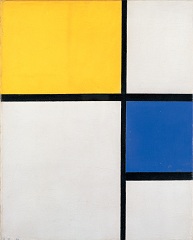
- Piet MONDRIAN, Composition No.1
(1929)
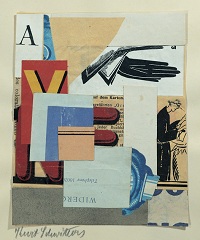
- Kurt SCHWITTERS Ohne Titel(uf dem Karton)
(1929/30)
The section of Nihonga (Japanese-style paintings) features the artworks of Murakami Kagaku, who was instrumental in establishing the Kokuga Sosaku Kyokai (Society for the Creation of a National Style of Painting), together with Tsuchida Bakusen. We organized his retrospective, which was held for the first time after his death, as our very first Nihonga exhibition in the year of the museum's founding. Having left the Kokuga Sosaku Kyokai, Kagaku completely severed ties with art circles and cloistered himself in Hanakuma, Kobe. His artworks were only known to a limited number of devoted fans for a long time. Commemorating this retrospective which gave crucial momentum to the reevaluation of Kagaku in the art history, we try to capture the quintessence of Kagaku's world of art, by focusing on total 40 exhibits, including Kiyohime at the Hidaka River (to be exhibited from June 11) which was designated as an important cultural property and loaned from the National Museum of Modern Art, Tokyo, as well as Kagaku's works from our collection and deposited works. (Some exhibits may be subject to replacement during the exhibition period.)
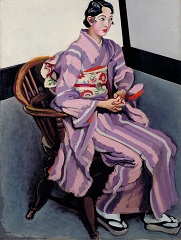
- YASUI Sotaro Seated Woman (1930)

- MURAKAMI Kagaku
Kiyohime at the Hidaka River (1919)
At the section of Yoga (Western-style paintings) selected masterpieces created around the Taisho era (1912-1925) are on display. The Taisho period coincides with the period of the Dada movement in the west, and that of the Kokuga Sosaku Kyokai in Japan. At that time, especially after World War I, a large number of Japanese painters went to Europe and confronted western art at its source. (For example, Odilon Redon's Bouddha dans sa jeunesse (to be displayed until June 23) was purchased in Europe and brought back to Japan by Tsuchida Bakusen.) As in the case of Umehara Ryuzaburo's Half-naked, some paintings show the straight influence of foreign masters such as Renoir. The Japanese oil paintings during this period, however, can be interpreted as the fruits of the Japanese artists' efforts to truly absorb and integrate western-style art into their own.
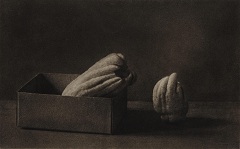
- NOJIMA Yasuzo Busshukan (Fingered Citrons)
(1930)
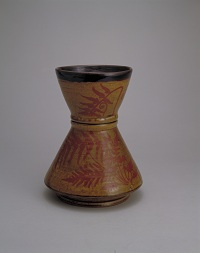
- KAWAI Unosuke Jar with fern design (1959)
The photography section features works of Nojima Yasuzo in connection with the special exhibition on the 3rd floor "The Shibakawa Collection: Tribute to a Patron of Aoki Shigeru, Kishida Ryusei and others." Active as a photographer in New Photography Movement in Japan from the Taisho to the early Showa periods, Nojima also ran a gallery and cultural salon by himself, serving as the patron for such talented artists as Umehara Ryuzaburo, Kishida Ryusei and Tomimoto Kenkichi. The relationships with them exerted a great influence on his own creation in photography as like as the experimental compositions of human bodies.
The applied arts section is centered around the ceramic works of Tomimoto Kenkichi, who had close ties with Nojima Yasuzo, and ceramic and textile works of other artists, who were also supported by the collector Shibalawa Terukichi and especially intended to the innovative creation in the utilitarian wares. Selected masterpieces of ceramic works by Kawai Kanjiro, one of the most prominent units in our collection, are also on display.
Themes of Exhibition
- ・Modern Art in the West from the Museum Collection Ⅰ
― Development of the Figurative and Birth of the Abstractive - ・Modern Art in the West from the Museum Collection Ⅱ
― DADA Movement - ・Commemoration of 50th Anniversary: MURAKAMI Kagaku
- ・Nojima Yasuzo, Photography
- ・Japanese Modern Craft and Textile
- ・KAWAI Kanjiro
- ・Japanese Modern Oil Paintings from the Museum Collection
― Selected Masterpieces around the Taisho Era (1912–1925) - ・Outdoor sculpture


